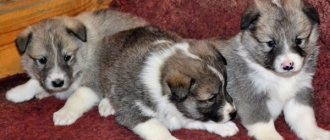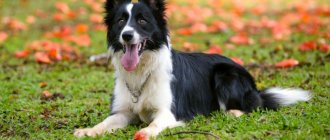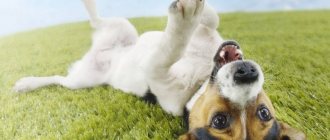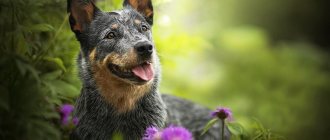The collie is also called the Scottish Sheepdog. This is a very fluffy and large dog. She has well-developed herding and watchdog qualities. If a collie is trained correctly, it will become an excellent guide dog for people with visual impairments. This is the most beautiful of all herding dogs. She has an even posture, which expresses her activity and looks proud.
The collie breed is known from the movie “Lassie,” about a kind and loyal dog.
Breed characteristics
| Short description | |
| Origin: | Great Britain |
| Conditions of detention: | House with or without garden, apartment |
| Purpose: | Cattle dog, hound dog, toy dog, companion dog |
| Color: | Sable, tricolor (black with tan markings), silver blue with black spots |
| Wool length: | Long |
| Adult dog size: | The height of females is 51-56 cm, males 56-61 cm, weight of males is approximately 26-34 kg, females - 19-26 kg |
| Average life expectancy: | 12-15 years |
| Walk: | Walking twice a day is required |
| Physical activity needs: | High physical activity needs (regular or daily exercise for more than 3 hours per day) |
| Fédération Cynologique Internationale (FIC) classification: | Group 1: herding and cattle dogs; Section 1: Shepherds |
| Puppy price: | From 12,000 to 30,000 rubles. Without pedigree – 12,000-13,000 rubles, pet class – 15,000-20,000 rubles, breed class – 25,000 rubles, show class – 30,000 rubles |
History of the origin of the species
Collies are long-haired herding dogs that have been serving people since the 14th century (the first documents refer to it). The poet Chaucer was the first to record these animals in his works, and after that the breed was described in many books: “History of Quadrupeds”, “English Dogs” and “Encyclopedia Britannica of Dogs”.
The name of the breed has two origins. According to the first version, “ Collie ” is a transcription of the English word “ cooly ”, which is translated as “ coal ”. This is exactly the color that the first representatives of Scottish Shepherds had. Second version: “ colleys ” is the breed of sheep that these dogs herded.
It is not known exactly who the ancestors of shepherd dogs were. There are two opposing opinions, according to which Collies were either introduced by Roman legionnaires, or they already existed in Scottish lands . The shepherds were busy driving the herd into one heap. They did not need to protect the sheep from the wolves, because they had long since been exterminated. This saved the Scottish Shepherds from aggression.
The popularization of the breed began in 1860, when Queen Victoria noticed the Collie and transported several individuals to London. The breed was divided into several types: Border collies remained shepherds. In 1881 the standard was published. Active breeding work began to breed colored individuals, and not just black ones. Dogs with thick and long coats were selected.
In the 19th and 20th centuries, Collies spread to other countries. In the Soviet Union, for example, they were used as service personnel.
A new surge in popularity occurred in 1940, when Eric Knight released his novel “Lassie Comes Home,” in which the main character is the Collie dog. In 1943, the first film was released, and numerous films and sequel series were made in which Lassie showed her devotion.
How much does it cost and what should I name the puppy?
The optimal age for purchasing a dog is 2-2.5 months. It is advisable to buy a collie puppy from special nurseries. Private individuals can offer you a mongrel or mixed breed puppy.
Approximate prices:
- private individuals - 10-20 thousand rubles;
- nursery (without the possibility of breeding) - 40-45 thousand rubles;
- nursery (with the possibility of further breeding) - about 70 thousand rubles;
- collie with excellent characteristics, documents, titled parents - from 95 thousand rubles and above.
The cost of female puppies is usually about 10-15 percent higher.
The name or nickname given to the puppy should be well-pronounced, harmonious, and most importantly, the pet should like it.
The owners of the nursery assign names on the 45th day of life. This name appears in pedigrees and in show events. Pet nicknames differ from official names.
Often representatives of this breed are given names that are consonant with English, Scottish or geographical names.
Would you like to get yourself a border collie?
Distinctive features
The first Collies were somewhat larger than modern ones. This is evidenced by the dog standard in the USSR, where the average height is 63-65 cm. Nowadays, shepherd dogs are of average height ( 51-61 cm ), rather squat, well-built, elongated. The sexual type is well defined, females are much smaller. The difference in weight can reach 15 kilograms .
Distinctive features include long thick fur and a fox-like muzzle with cunning shiny eyes. The latest standard was published in 1988, according to which all dogs that do not meet external characteristics are discarded.
- The head is wedge-shaped, narrow, dry. The skull is wide and flat, as are the cheekbones. The stop is weakly expressed, but easily perceptible.
- The muzzle is narrow, rather long, parallel to the lines of the skull. Powerful lower jaw . Scissor bite The cheeks are flat. The bridge of the nose is tilted down.
- The nose is large. Definitely black.
- The eyes are set narrowly, slightly slanted, almond-shaped. Brown and blue colors are allowed.
- The ears are small, set high, but not wide. In an active state, they are raised and slightly tilted forward, in a calm state they are laid back.
- The body is strong and elongated. The topline is straight. The croup is round and sloping. The scruff is smooth and beautiful.
- The tail is set low, hangs down when calm, and is long, reaching the hock joint.
- The limbs are parallel and strong. Long shins are characteristic. The feet are oval, with well-knit toes. The movements are trot-like, light, sweeping.
- The coat is long, straight, thick and hard. Forms feathering on the ears, limbs and tail; mane on chest. There is a soft undercoat.
- Colors: fawn, mahogany, tri-color, black harlequin.
Collie varieties
The collie group includes many more breeds than might be expected. We are talking not only about dogs bred in Scotland, but also about those herding breeds that were created in different parts of the world based on the blood of the Scottish Shepherd. And although the purpose of the dogs is essentially the same, the appearance of some of them may surprise. Australian experiments to create an ideal shepherd dog turned out to be especially interesting.
This is not a mother with a puppy, but two completely different breeds of collie: Shetland and Scottish Sheepdogs
Australian short-tailed cattle dog
To breed the breed, not only collies were used, but also other European shepherd dogs, to which the blood of dingo dogs was added. The result is a strong, smart and hardy dog that is excellent at herding cattle.
The Australian short-tailed cattle dog is a lightly built animal with short hair and erect ears.
Australian Shepherd (Aussie)
Despite its name, the breed was developed in the USA; Her spectacular appearance and good character made her in demand all over the world. It has a very beautiful thick coat, often with odd eyes. It is rarely used for its intended purpose.
The Australian Shepherd (Aussie) is descended from the English Collie with Basque and Spanish Shepherds included.
Australian heeler
The Australian Heeler is an excellent working dog, shepherd and guard dog. Brave, independent, but human-friendly dog. The breed was developed by crossing the Australian dingo dog and a short-haired variety of the Scottish Sheepdog.
The Australian Cattle Dog (Australian Heeler) has a characteristic blue or red mottled color with tan.
Australian Kelpie
Like the Heeler, the Australian Kelly is originally a cross between a dingo and a collie, but the resulting dogs are different. Kelly is the pride of Australian cynology. The breed is recognized all over the world and is already used more for sports and shows than for banal grazing.
The Australian Kelpie is a short-haired dog with erect ears, black, grey, red, red-brown or chocolate in color.
English Shepherd
At the turn of the last century, the English Shepherd was probably the most numerous breed in the United States. The Americans developed this versatile hard worker based on various mixed breeds of Scottish Shepherds brought to North America.
The English Sheepdog was bred to perform many tasks on small multi-purpose farms
Blue Lacy
The only breed of Texas selection, the Blue Lacy, was bred here at the beginning of the 19th century and turned out to be very successful both in appearance and in working qualities. A cross between an English Shepherd and various purebred and mongrel dogs. Recognized as the official symbol of Texas.
Blue Lacy is a herding breed and serves in the North American south
Border Collie
The Border Collie is considered the most intelligent breed in existence. In addition, she is the most hardworking and most passionate of all the collies. Working lines are highly valued; Borderers are excellent at herding sheep, goats and poultry, but are not good at handling cattle.
The Border Collie is the most famous breed specializing in herding sheep.
Bearded Collie
Charismatic appearance, friendly disposition, enviable trainability - the bearded collie has so many advantages that it would be a sin for him to remain a simple shepherd. Today it is an expensive and prestigious breed that flaunts at exhibitions and performs well in sports competitions.
The Bearded Collie is a confident and active, reliable and intelligent dog.
New Zealand Collie
The New Zealand Collie is not very similar to the collie we are used to. This is a rare and as yet unrecognized working breed, one of the progenitors of which is the Border Collie. Such dogs hardly bark, and their owners like to say that the dog controls the flock with just his gaze.
The New Zealand Collie has a special way of herding sheep.
Sheltie
The Shetland Sheepdog may look like a dwarf variety of the Scottish Sheepdog, but this is not the case. The breeds have different origins: Sheltie descends from Spitz dogs, which were crossed with local herding dogs, and mixed breeds were initially called Tuni Dog, which translates from Gaelic as “farm”. Then collie blood was added to the breed, and soon it ceased to be used in dog work - now it is an excellent companion dog.
Sheltie should have the appearance of a miniature collie
Photo of an adult dog
Photos of puppies
Features of character and behavior
Collies are very loyal and affectionate dogs, completely focused on humans, living side by side with him for several hundred years and serving him faithfully . They make not only good working dogs, but also companions. They are friendly and devoid of aggression.
Like all Collies, Shetland Sheepdogs are very intelligent. They have developed instincts of shepherds and hunters, they are easy to learn and train. But thanks to their high intelligence they can be cunning. These pets cannot be called simple, but they are suitable for beginners.
Advantages
- Collie is one of the best breeds for a family . They are kind, cheerful, playful and very cute. They get along easily with children (good nannies) and other pets. Ideal as a pet, they are endlessly devoted to their family and will never run away from home.
- Well built, athletic and active. They will be a good partner for running, cycling, swimming (they love water). They adapt to any conditions and can live in a city apartment or a private country house. Still haven't lost their shepherding abilities.
- They are absolutely not aggressive even towards strangers and dogs. They will find a common language with any person. In case of danger, they can protect themselves and their owner.
- Beautiful and important, they know how to show themselves in public ; proud enough that they show it with their entire appearance.
Flaws
- Collies cannot live without a person. They miss their owner a lot when he is at work. Categorically not suitable for chain and aviary keeping. They cannot stand loneliness.
- Quite noisy, they love to bark and run. Although they themselves cannot stand loud sounds: music, screams. They have a bad attitude towards family quarrels. Quite touchy and vindictive.
- They can be cunning and deceive . Without proper upbringing, they become either withdrawn and timid, or too restless and proud.
- Needs long active walks and can cause chaos in the house. Requires special care, sheds a lot and profusely.
Purpose of Collie dogs
Thanks to their irrepressible disposition, collies do not object to working for the benefit of humans, but on the contrary, willingly agree to serve people.
Despite the varieties, all breeds show many talents; these are dogs with great potential. They are obedient, flexible, and well trained, which is why people use collies in various directions and areas of activity. They make excellent detective “workers”, irreplaceable rescuers, and responsible guides.
Care and maintenance
The collie is a long-haired breed that sheds frequently and profusely, so it requires constant brushing. In general, caring for Scottish Shepherds is no different from caring for any long-haired breed.
The fur of these dogs has healing properties. Products knitted or rolled from it can cure various diseases. In addition, they come out very soft and warm.
You need to keep such a dog near your family. Otherwise there are no regulations. This is not a very large dog, so a city apartment will be enough for her. Of course, a shepherd dog will feel best in the countryside in a private house with free access to a shady yard.
Nutrition
Collies can be fed both dry food and natural food. The first option attracts breeders due to its ease of use. But in this case, you need to select only premium class products for active breeds with long hair. The best option would be holistic food (grain-free food). Dry foods still need to be diluted a little with water or broth for better absorption.
- With natural feeding, 50% of the diet should be lean raw or boiled chicken, lamb, veal or rabbit.
- Another 30-40% belongs to cereals.
- The rest of the menu can be divided between fermented milk products, boiled eggs, sea fish and plant foods.
The diet NOT include the following foods:
- Potatoes, melon, grapes (high levels of starch);
- White bread and flour products;
- Sweet;
- Boiled tubular bones;
- Pork;
- Butter;
- Citrus;
- Onion garlic.
The frequency of feeding depends on the age of the dog. Puppies are fed 5-6 times, adult pets - 2 times a day (morning and evening). Food should be warm and soft. On average, an adult Collie eats 500 grams of dry or natural food per day.
Health
Collies are original dogs; there was practically no human participation in the selection process, so the principle of “survival of the fittest” worked. The breed is in good health and has a strong immune system. There are not very many hereditary diseases. On average, pets live 12-15 years.
Of course, a dog’s life expectancy depends on care, nutrition, timely vaccinations and examinations at a veterinary clinic.
Vaccinations
Puppies begin to be vaccinated at 1.5-2 months , when maternal immunity ceases to function. As a rule, the first vaccinations are carried out by nurseries. The owner who bought the pet must follow the vaccination calendar:
- Complex vaccination is carried out at 1.5, 2, 6, 12 months and annually;
- Anti-rabies treatment is carried out at 7 months and is repeated annually.
Certain vaccination rules should be followed to avoid possible problems. Dogs must be absolutely healthy; Pregnant and lactating females and hypothermic pets are not allowed.
2 weeks before vaccination, the pet undergoes a deworming procedure . If you observe long-term negative side effects, you should contact a veterinary clinic.
The cost of vaccination depends on the status of the veterinary clinic. Most often, vaccination costs 400-1000 rubles.
Diseases
- There is a risk of several congenital diseases: blindness, deafness and eye deformities. To avoid such problems, you need to talk with the breeder and ask him about the defects of the parents.
- Due to their long hair, Collies are susceptible to skin diseases: allergic reactions to food and hygiene products, dermatitis and irritation, skin infection (staphylococcus).
- Various dislocations and sprains may occur . There is a risk of developing hip dysplasia. This disease is characterized by acute pain when walking, eversion of paws, and lameness. Unfortunately, at the moment it is incurable, but you can alleviate your pet’s suffering with medication or surgery. To avoid such problems, you need to avoid excessive stress on the hind legs.
Healthy Collies are cheerful and active. In case of refusal to eat, bad mood, unpleasant symptoms (vomiting, diarrhea, change in urine color), you should consult a doctor to immediately prescribe a course of treatment.
Walk
Collies are very active dogs and need to burn off their energy. Thus, if a pet lives in an apartment or indoors, then he needs to walk 3 times a day for 1-1.5 hours with jogging and games. If the shepherd has free access to the yard, then 1 hour of training a day is enough.
These dogs love to swim. A trip to a pond on a hot day will be a real joy for them. Ball games are one of the most popular pastimes for pets, and Collie is no exception.
You can walk the puppy after the second vaccination. Small shepherd dogs are not heavily loaded - they are walked 3-4 times a day for 20-30 minutes . It is necessary to accustom your pet to walks on a leash and without it. Collies are not prone to running away.
Photo: Larisa Kadina
Grooming
There are several basic points for caring for a long-haired Collie:
- The coat must be combed 3-4 times a week during the period of active shedding (spring and autumn). Comb daily using a furminator;
- are bathed 2-3 times every six months and when soiled; shampoos are purchased for long-haired dogs;
- After walks , wipe the dog with a damp towel and wash its paws under warm water;
- Eyes should be wiped with chamomile solution daily;
- Ears are examined every day; treated 2-3 times a week with antiseptic solutions, excess hair is cut out (in the auricle);
- Nails are trimmed once a month;
- Teeth are brushed once every 2 weeks;
- Worms are removed every 2-3 months;
- During the summer, it is important to treat the fur against fleas and ticks.
The dog actively sheds almost always. The owner must come to terms with the fact that cleaning will have to be done every day.
Rules for caring for collie puppies
Need to know! It is recommended to feed the puppy frequently, at least 4-5 times a day. Portions should be small. Overfeeding is contraindicated, as excessive “care” can harm the digestive system of the little collie.
Puppies are given a balanced menu in advance, consisting of natural and fresh products. This could be soups, dairy products, rabbit meat, purees, cheeses, broths, etc.
To strengthen bone and muscle tissue, you should give foods enriched with calcium (cheese, milk, cottage cheese, etc.). This also applies to adult dogs.
Prohibited foods for Collie puppies
- fatty food;
- canned food, especially fish;
- peppered food;
- semi-finished products;
- sugar, chocolate and other sweets.
Recommendations for the diet of an adult Collie dog
For an adult dog, 3 meals a day will be enough. She can already be given dry supplements in the form of feed. To improve the condition of the coat, it is recommended to include in the diet:
- Boiled potatoes;
- millet;
- bread (preferably rye);
- buckwheat;
- lean fish;
- not sharp bones, maybe chicken bones.
Important! If you decide to pamper your pet with a bone, it should not be spicy. If fish is included in the diet, then you must make sure that there are no bones so as not to injure the animal’s esophagus.
Collie deserves attention. The breed has many advantages and almost no disadvantages. You have to love your pet, and he will reciprocate.
Mating
Collies are medium-sized dogs, but mating should take place in a free room with the participation of a specialist. Both pets are checked for pathologies and diseases, and treated for worms and external parasites.
Shepherd dogs reach puberty at 8-10 months, but they can be bred starting at 18 months. During this period, the bitch should already be in her third heat and show signs: swelling of the loop, light discharge, playful behavior.
- The girl is brought to the male dog’s territory, where the animals are given time to get acquainted and sniff (15-20 minutes).
- When the female is ready, she will allow the male to mount.
- At this time, the owner must support the bitch under the belly so that she does not sit down.
- The boy is sent to the noose.
- During the lock, pets should be in a comfortable position.
- Mating is repeated after 2 days.
Description of Collie dogs
If you look at a photo of a collie, you can see a stately, independent and proud dog. However, first impressions are deceiving. The description of a collie should begin with its character. This is an affectionate, good-natured, playful animal with a pleasant appearance.
The largest representatives are considered to be long-haired Scots, reaching 60-62 cm at the withers. Other breeds - less.
Key points in training
Collies are very smart dogs . They don't need a lot of explanation for them to understand. They like to follow their owner's commands. From the first days, puppies need to be taught their name and daily routine. The dog must know the feeding and walking regime and adapt to the owner.
By 4 months, the puppy will already have learned its name. During this period, you can begin training the basic commands: “near”, “place”, “sit”, “no”. You cannot use rude methods; Scottish Shepherds are very touchy and vindictive. The best way to motivate your puppy is with toys or treats. All training should be fun.
You can attend a dog training course with dog handlers. They will help the owner understand the mechanism of communication with the pet and make the task of raising it easier.
Read about how to properly train a dog in the article: “Training a puppy: effective methods from dog handlers, learning commands at home.”











